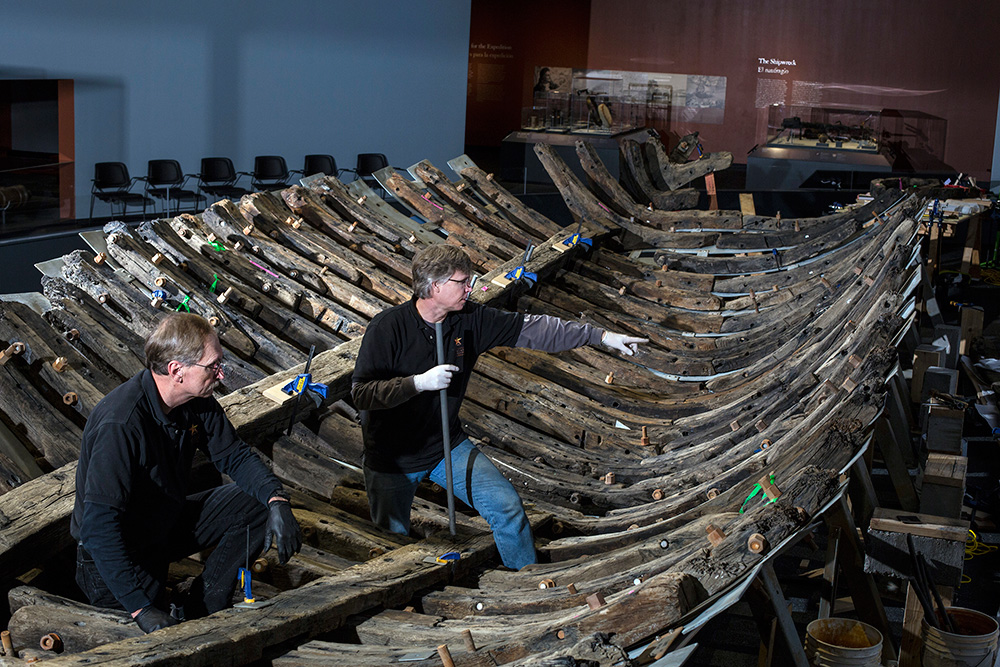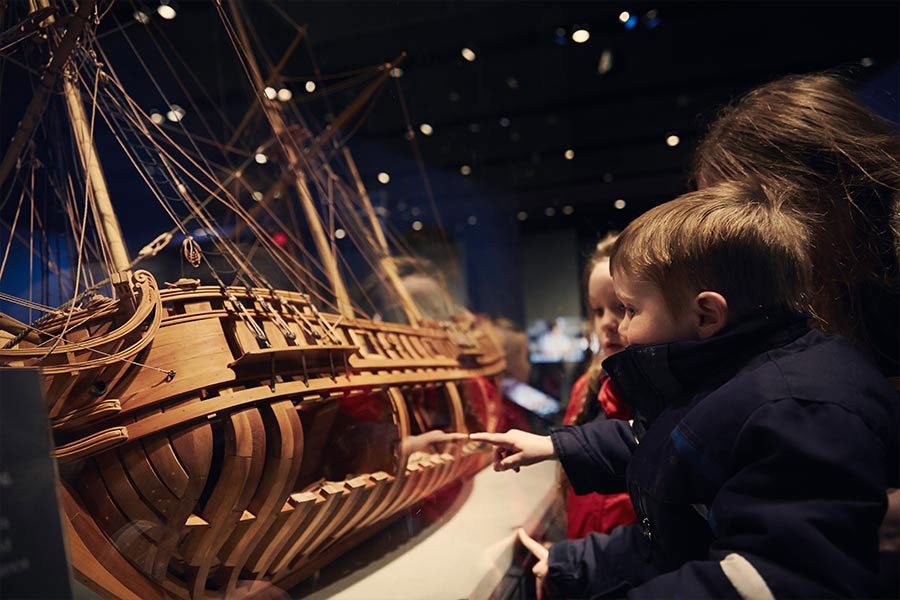Journey's end is a new beginning at the Bullock
Ship's last passage signals a new era at state history museum
MAY 12, 2015 (AUSTIN, TX) — After 330 years under water off the coast of Texas, the French ship "La Belle" will be moved to its final destination this month, signaling a new era for the state's history museum. French explorer Robert Cavelier, Sieur de La Salle's ship that sank in Matagorda Bay in 1686, and was excavated in the mid-1990s, now has been reassembled at the Bullock Texas State History Museum. The ship will become the centerpiece of the museum's galleries when it is moved to its permanent location within the museum on May 21, 2015.
"La Belle: The Ship That Changed History," considered to be one the most significant exhibitions on European colonization in the United States, closes May 17 at the Bullock Museum in Austin. In February, the entire first floor of the museum's permanent exhibitions was closed to prepare for a major renovation centered on the addition of the reassembled ship to its permanent galleries. About 11,000 of the museum's 34,000 square feet of space will undergo a complete transformation over the next 18 months during this $10-million project to renovate the Texas History Galleries.
Ralph Appelbaum Associates (RAA), the world's largest museum exhibition design firm, was chosen to develop the design, and museum staff have engaged scholars to research and develop a new interpretive approach that examines the dynamic and complex encounters between regional American Indians, the French, and the Spanish that greatly influenced the course of global history and laid the foundation for Texas's own unique story.
The new approach will feature hundreds of original artifacts spanning 13,000 years of history. A fresh design and new digital media components will provide visitors with a new and deeper understanding of the story of Texas.
"Featuring a shipwreck of this age and magnitude offers visitors one of the most unique experiences in any museum in the country," Bullock Museum Director Dr. Victoria Ramirez said. "Permanently featuring the ship and its cargo as the centerpiece of the museum's first floor galleries offers visitors a compelling look at a little-known era in Texas history."
It is rare for a state history museum, or any museum, to have such a comprehensive collection of artifacts from the 1680s, according to Ramirez. La Belle and its cargo will combine with other original artifacts, documents, and interactive video on the first floor to tell the story of early Texas through 1821.
The cornerstone of the special exhibition that opened Oct. 25, 2014, has been a live-action rebuild of the ship by conservators in full view of visitors and streaming online. During the seven-month exhibition, a staff of three experts spent 2,400 hours reassembling this important piece of Texas history. The exhibition brought together for the first time the 17th-century ship timbers, more than 120 of the 1.6 million artifacts excavated in Matagorda Bay, never-before-seen video footage, and a 4D film that tells this important Texas narrative.
"La Belle is really two stories," Ramirez said. "One of a 17th-century French expedition that would change the course of Texas history. And another of a 21st-century excavation and conservation project that will preserve this piece of history in perpetuity and give visitors a chance to experience original artifacts that relate to this important time in Texas history."
On April 8, 2015, the Texas Association of Museums awarded "La Belle: The Ship That Changed History" its highest honor — the President's Award, which recognizes excellence in the museum field. The "La Belle" exhibition has been featured on television programs airing on C-Span and the Travel Channel and will be the subject of an episode of the international series "Salvage Masters" this summer. This unique Texas story was featured in Popular Mechanics and on the cover of American Archaeology magazine, in addition to receiving national and international coverage in major magazines, newspapers and online outlets.
Downloads
The Bullock Museum collaborates with more than 700 museums, libraries, archives and individuals to display original historical artifacts and produce exhibitions that illuminate and celebrate Texas history and culture. This steady rotation of original artifacts, combined with the first-floor renovation and other updates to the permanent galleries, will allow visitors to experience a "new" Bullock Museum in 2016.
For more information and updates, visit TheStoryofTexas.com and follow the Bullock Museum on Twitter and Facebook.
Media Contact
| General Inquiries | |
|---|---|
| 512-463-5424 | |

